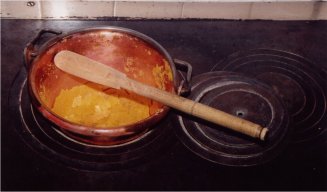|
|

Paról and polentàr on the fornasèla
|
|
I CANEDERLI
Per fare dei canéderli col brodo e col ragù se ciapa del preźemolo e se lo taia su, farina, óvo e źigole, luganeghe col spéck, pan vecio senza migole e 'n toc de formai ∫gnèc. Se fa balòtole col pan gratà tre', quatro fregole de ai pestà 'na meʒa chichera de lat e vin èco i canederli de noi Trentìn'. Ensèma coi canederli noi altri ghe magnàn 'na tesa de luganeghe e 'n toc de smacafàm ne pias polenta e fìnferli, la mòsa con él lat capuśi con le scódeghe che vanźa fór dal piat. Par la maiolica 1 inoltre gh'è capuśi e crauti su per Piné; g'aven le trote gió lì a Toblìn col vino santo e 'l Marźemìn |
Translation:
THE CANEDERLI To do some canederli with the broth and with the meat sauce you've to take some parsley and chop it, flour, egg and onions, luganeghe with the speck, old bread without crumbs 2 and a piece of soft cheese. You've to make pellets with the bread crumbs three, four cloves of crushed garlic half cup of milk and wine here are the canederli of us people of Trentino Together with the canederli we're used to eat a nosh-up of luganeghe and a piece of smacafàm we like polenta with chanterelle mushrooms, the mòsa with the milk cabbages with pork rinds that spread out the dish. To eat there are also cabbages and sauerkraut in Piné; we've got the trouts down there in Toblino with the wines vino santo 3 and Marzemino. |